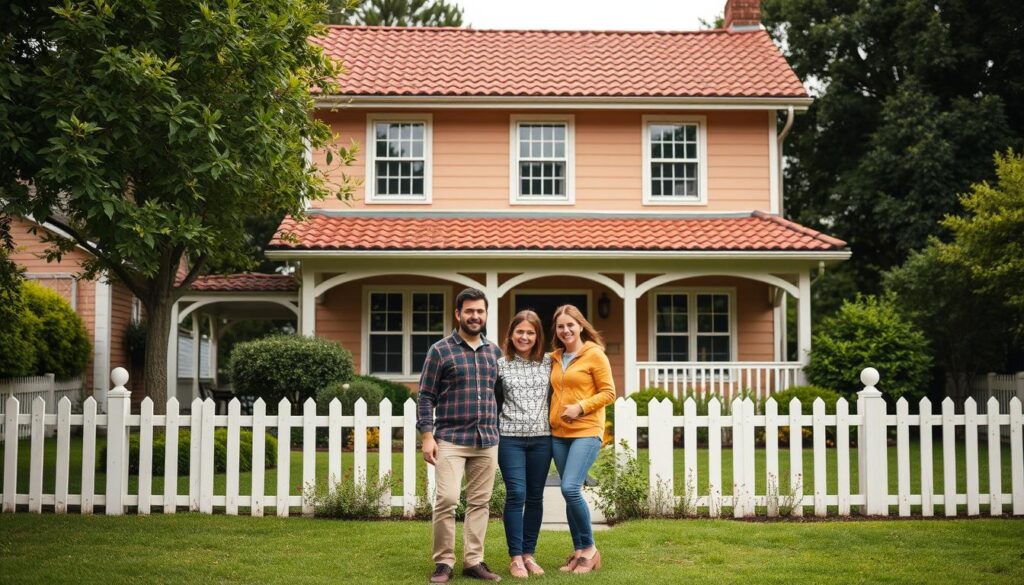
Welcome to our guide on Assurance Habitation. Here, we’ll cover everything you need to know about protecting your home. We aim to give you the knowledge and tools to safeguard your most valuable asset.
Home insurance and property protection are key for homeowners. The right assurance habitation ensures your home and belongings are safe from unexpected events.

A cozy two-story house with a well-manicured lawn, surrounded by lush greenery and a picket fence. The exterior is adorned with warm, earthy tones, complemented by a neatly tiled roof. In the foreground, a family stands together, smiling and content, symbolizing the sense of security and protection that a home insurance policy can provide. Soft, diffused lighting illuminates the scene, creating a welcoming and comforting atmosphere. The composition is balanced, with the house and family occupying the central focus, suggesting the importance of safeguarding one’s home and loved ones.
We want to help you understand home insurance and assurance habitation. Our goal is to ensure you have the right property protection in place.
Introduction to Assurance Habitation
Assurance habitation is vital for homeowners. It offers the protection and peace of mind you need. With the right home insurance, you can safeguard your home and belongings against damage or loss.
Key Takeaways
- Assurance habitation provides protection for your home and belongings
- Home insurance is essential for financial protection against unforeseen events
- Property protection is crucial for safeguarding your most valuable asset
- Understanding assurance habitation is key to making informed decisions about your home insurance
- The right home insurance policy can provide you with peace of mind and financial security
Understanding Assurance Habitation Basics
Protecting your home is key, and knowing about home insurance is essential. It’s important to understand what home insurance covers, the types of coverage, and legal needs for homeowners. This knowledge helps you choose the right insurance for your home.
Home insurance protects against unexpected events like natural disasters, theft, and accidents. There are various coverages, including liability, property damage, and personal items. Knowing these options helps you pick the best policy for your needs and budget.
What Home Insurance Covers
Home insurance shields you from fires, floods, storms, theft, and vandalism. It offers financial protection against these losses. Knowing what it covers helps you find the right amount of insurance for your home.
Types of Coverage Available
There are several types of coverage:
- Liability coverage: protects you from lawsuits and legal costs
- Property damage protection: covers damage to your home and belongings
- Personal belongings protection: covers loss or theft of personal items
Legal Requirements and Obligations
It’s crucial to know the legal side of owning a home. In many places, home insurance is a must. Without it, you could face fines and penalties. Understanding these laws ensures you follow the rules.

A cozy, well-lit living room filled with essential home insurance elements. In the foreground, a stack of documents and a pen symbolize the paperwork involved. In the middle ground, a family gathers around a table, discussing their insurance plan. The background features a large window overlooking a tranquil suburban neighborhood, conveying a sense of security and protection. Warm, soft lighting illuminates the scene, creating a welcoming and reassuring atmosphere. The composition emphasizes the importance of understanding the basics of home insurance to safeguard one’s property and loved ones.
By grasping home insurance basics, you can make better choices for your policy. This protects your home and finances from unexpected events.
Evaluating Your Home Insurance Needs
To figure out your home insurance needs, you need to do a detailed coverage assessment and risk evaluation. Think about your home’s value, the cost to rebuild it, and what your personal stuff is worth. Knowing your specific needs helps you choose the right policy. This way, you won’t have too little or too much insurance.
When looking at your home insurance needs, consider a few things:
- The cost to replace your home and its contents
- The chance of natural disasters like floods or earthquakes in your area
- The worth of special items, like jewelry or artwork
A good coverage assessment and risk evaluation will show you how much coverage you need. It’s also key to check and update your policy often. This makes sure it still fits your home insurance needs as they change.
A cozy living room with a plush sofa and armchair, a coffee table with home insurance documents, and a desk in the background with a laptop and paperwork. Warm lighting from a floor lamp and natural light filtering through large windows. A sense of security and protection, with a subtle air of professionalism and attention to detail. The room conveys the importance of evaluating and securing one’s home insurance needs.
By carefully looking at your home insurance needs and doing a detailed coverage assessment and risk evaluation, you can get the right protection for your home and stuff.
Essential Coverage Components
Home insurance has several key parts to think about. These parts work together to protect your home and things inside it. Knowing about these parts helps you choose the right insurance.
Property damage coverage is important. It helps fix your home if it gets damaged by natural disasters, fires, or other unexpected things. Also, liability coverage is key. It helps if someone gets hurt on your property and you need to pay for their medical bills or lawsuits.
Protection for Your Belongings
Personal belongings insurance is also crucial. It protects your personal items like furniture, clothes, and electronics from theft, loss, or damage. This way, you can replace or fix your items if something bad happens.
Additional Coverage Options
Other important parts include coverage for extra living expenses. This helps with costs for temporary housing and living if your home is not safe to live in. By picking the right coverage, you can feel secure knowing your home and things are safe.
Determining Your Coverage Limits
Choosing the right coverage limits is key for insurance valuation. It ensures you have enough insurance to rebuild or repair your home and replace your belongings if lost. Think about the cost to rebuild your home, the value of your personal items, and any extra structures on your property.
Policy limits need to be checked and updated as your home’s value or personal situation changes. This could be due to increased property value, new home additions, or changes in your income and expenses. Regularly reviewing your policy limits helps keep your insurance coverage up to date with your needs.
Important factors to think about when setting your coverage limits include:
- The replacement cost of your home and any additional structures
- The value of your personal belongings, including furniture, appliances, and other possessions
- Any additional coverage needs, such as flood or earthquake insurance
By carefully considering these factors and regularly reviewing your policy limits, you can ensure you have the right insurance coverage. This protects your home and belongings. Remember to also consider your insurance valuation and coverage limits to ensure you are adequately protected in the event of a loss.
Factors Affecting Insurance Premiums
Insurance premiums have many factors. The cost of your home insurance can change based on where you live, your home’s construction and age, and its security. Knowing these can help you choose the right insurance for your home.
Where you live can raise your insurance costs. For example, homes in areas at risk for natural disasters or high crime rates cost more. The age and materials of your home also play a part. But, adding security like alarm systems can lower your premiums.
Location Considerations
High-risk areas can greatly increase your insurance costs. Homes in flood zones or wildfire-prone areas need extra coverage, raising premiums. Also, homes in areas with lots of crime are more likely to be stolen or vandalized, leading to higher costs.
Home Construction and Age
The materials and age of your home can also raise your premiums. Older homes are riskier and cost more to insure. Homes made of wood, for example, are more vulnerable to damage from natural disasters, increasing premiums.
Security Features Impact
Adding security features like alarms and smoke detectors can lower your premiums. These features help prevent damage or loss, making your home less risky for insurers. Securing your home can lower your insurance costs and protect your investment.
Understanding what affects insurance premiums helps you make better choices. Think about your location, home’s construction and age, and security features. With the right coverage, you can safeguard your home and finances against unexpected events.
Optional Coverage Add-ons
Having the right home insurance is key. Standard policies offer basic protection. But, optional coverage add-ons can boost your security. These include flood, earthquake insurance, and umbrella policies for extra protection against certain risks.
Some common policy enhancements include:
- Flood insurance: protects against flood-related damages
- Earthquake insurance: covers damages caused by earthquakes
- Umbrella policies: provides additional liability coverage
These add-ons are great for homeowners in disaster-prone areas or with valuable assets. They let you customize your policy to fit your needs and risks. It’s important to consider the benefits and costs of these optional coverage add-ons.
Investing in the right policy enhancements gives you peace of mind. Your home and assets are well-protected. Always check your policy to make sure it covers your current needs and add-ons.
Making a Home Insurance Claim
Filing a claim requires understanding the claims process and what documentation you need. This knowledge helps avoid common claim pitfalls that could slow down or lessen your claim. Start by collecting all needed documents, like police reports, receipts, and photos of the damage.
Having your documentation in order is crucial. Make sure to keep a record of all talks with your insurance company. Include dates, times, and what was discussed.
- Call your insurance company right away to report the incident.
- Give them detailed documentation of the damage or loss.
- Check in regularly to make sure your claim is moving forward quickly.
Being ready and informed helps avoid claim pitfalls. It ensures your claims process goes smoothly.
Cost-Saving Strategies for Home Insurance
Home insurance can be expensive, but you can cut costs. There are ways to save money without losing coverage. Start by comparing quotes from different companies to find the best deal.
Another smart move is to bundle your home and auto insurance. This can save you money and make managing your policies easier. Many insurers also offer discounts for homes with security systems, good credit, and loyalty. Improving your home’s safety features can also lower your premiums.
Some key ways to save include:
- Increasing your deductible to lower your premium
- Taking advantage of discounts for home security systems and other safety features
- Improving your credit score to qualify for better rates
- Shopping around for quotes and comparing rates from different providers
By trying these strategies, you can lower your insurance costs. Always check your policy and adjust it as needed. This way, you get the most value for your money.
Home insurance is an essential investment, but it doesn’t have to break the bank. By being proactive and exploring cost-saving strategies, you can protect your home and your finances.
Reviewing and Updating Your Policy
It’s crucial to regularly review your home insurance policy. This ensures it still fits your needs as they change. For example, if you get married or have kids, you might need to boost your coverage.
Many life events can prompt a policy update. This includes moving, getting a new job, or seeing a change in income. It’s smart to check your policy every year. This way, you can make sure it still covers what you need.
When you review your policy, consider a few things:
- Changes in your income or financial situation
- Additions or renovations to your home
- Purchases of new valuables or assets
- Changes in your family dynamics or dependencies
Regularly reviewing and updating your policy helps protect your home and family. Always talk to your insurance provider about any changes or updates you need.
Common Insurance Policy Exclusions
Knowing what your home insurance covers and what it doesn’t is key. Policy exclusions can lead to big costs if you’re not ready. Natural disasters like floods and earthquakes often have special rules or are not covered at all.
Maintenance problems, like mold or termite damage, might not be covered if they’re due to poor upkeep. It’s vital to check your policy for any gaps in coverage. Regular maintenance can help avoid some issues, but you might need extra coverage too.
- Natural disasters, such as floods or earthquakes
- Maintenance-related issues, such as mold or termite damage
- Damage caused by poor maintenance or neglect
Knowing about these exclusions helps you manage risks and get the right coverage. You might need to buy more coverage or take steps to avoid maintenance problems. Always check your policy to make sure it fits your needs.
Working with Insurance Providers
Choosing the right insurance provider is key for your home. A good one offers great customer service, handles claims well, and has options that fit your needs. It’s important to research and read reviews to find the best one.
Look at the provider’s financial health, reputation, and customer service. Also, check how they handle claims. This ensures a smooth process. By comparing different providers, you’ll find the best one for you.
Here are some tips for working with insurance providers:
- Ask questions about their coverage options and policies
- Check their financial stability and reputation
- Read reviews from other customers to get an idea of their customer service
- Understand their claims handling process and what to expect
Follow these tips and do your homework to find a great insurance provider. Always read the fine print and ask questions if you’re unsure. This way, you’ll get the service and coverage you need.
Conclusion: Securing Your Home’s Future with the Right Coverage
Choosing the right home insurance is key to protecting your biggest asset – your home. It’s important to know the different coverage options and what you need. Working with your insurance provider helps make sure your future security is covered with the right coverage.
It’s important to check and update your home insurance often. Your needs might change due to life events, home updates, or changes in the housing market. Talking regularly with your insurer helps keep your policy up-to-date and gives you peace of mind.
Your home is not just a building; it’s where your family’s well-being and dreams come to life. Getting the right home insurance is a smart move. It helps secure your future security and keeps your home safe for years to come.












